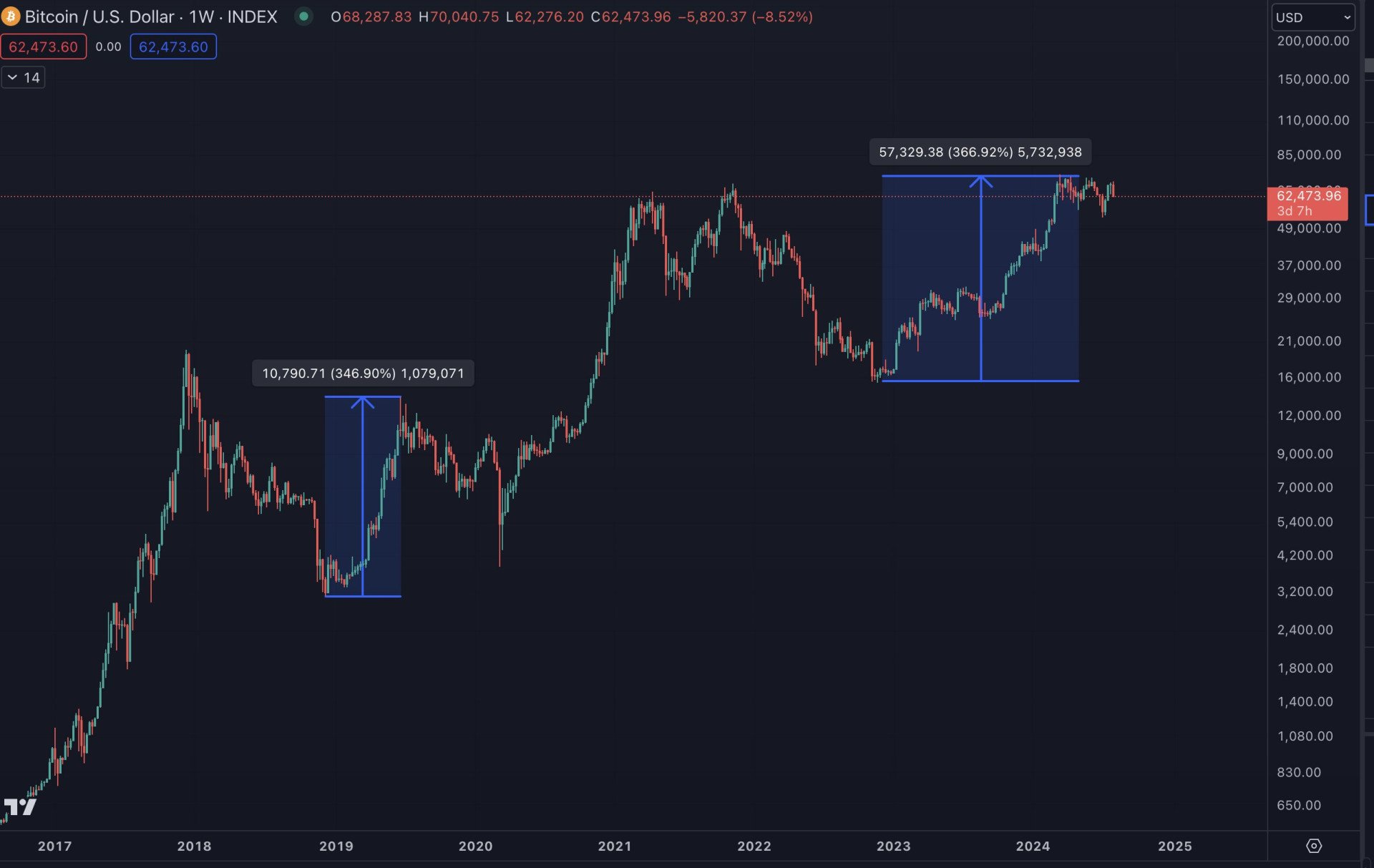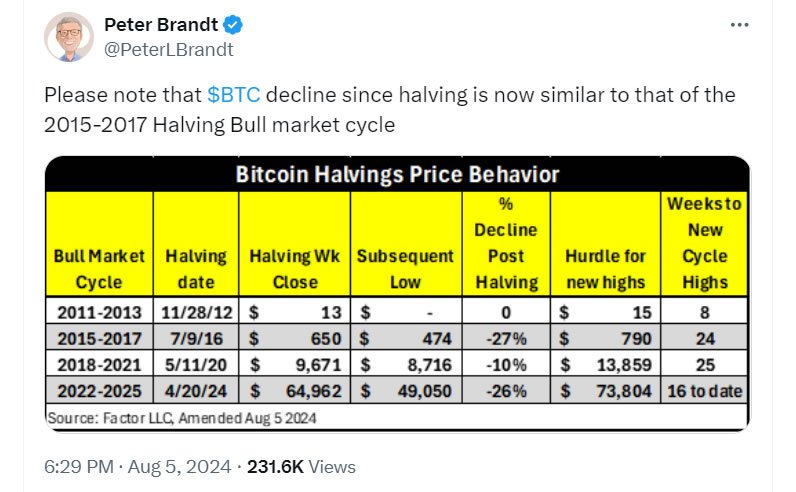Bitcoin decline since the April 2024 halving is starting to resemble market movements ahead of the bitcoin 2016 bull run, according to veteran trader Peter Brandt. Brandt, known for his insightful market analyses, shared his observations on social media, sparking discussions among crypto enthusiasts and investors alike.
In an X post on August 5, Brandt highlighted that the “Bitcoin decline is similar to the start of the bitcoin 2016 bull run.” He noted that the recent price drops mirror the post-halving corrections seen in previous cycles. “The BTC decline since halving is now similar to that of the 2015-2017 halving bull market cycle,” Brandt stated.
Comparing Market Cycles
Brandt compared how much the market fell after each halving. In 2016, Bitcoin’s halving happened on July 9, and the price was $650. After that, the market dropped to a low of $474, a 27% decrease, before skyrocketing to $20,000 in December 2017.
Similarly, Bitcoin’s recent fall below $50,000 represents a 26% drop from its post-halving price of $64,962. This comparison led Brandt to suggest that the “Bitcoin decline is similar to the start of the bitcoin 2016 bull run.” His observations have made some people hopeful that history might repeat itself.
Market Reactions and Predictions
However, some analysts warn that Bitcoin (BTC) could drop lower. On August 5, Bitcoin’s price fell to $49,221, according to CoinGecko, a 20% drop from its high of $70,000 in late July. Despite this, the market showed signs of recovery, with prices climbing back to $56,000 during early trading in Asia on August 6.
Benjamin Cowen, founder of ITC Crypto, said the current pattern looks like 2019 when the markets surged in the first half of the year and then corrected sharply in the second half. “The current Bitcoin decline is similar to the start of the bitcoin 2016 bull run — Peter Brandt,” Cowen noted, highlighting the cyclical nature of crypto markets.
Tim Kravchunovsky, founder and CEO of Chirp, a decentralized telecommunications network, believes that crypto assets can recover faster than other investments. “Macroeconomic factors are in the driving seat,” he said. “Over the coming hours and days, we may well see a decoupling of crypto from traditional stocks, similar to what we saw in 2020.”
Kravchunovsky added, “Back then, crypto bounced back much quicker from the pandemic-driven collapse than traditional stock markets, and we might see the same this time.”
Technical Analysis and Investor Sentiment
Bitcoin’s price movements have also been analysed using technical indicators. The Relative Strength Index (RSI) bounced back from the oversold level to surpass the 50-midline, now at 55, indicating that buyers are in control. The Moving Average Convergence Divergence (MACD) is bullish, climbing towards the neutral line and showing a bullish crossover as the blue MACD line crosses above the orange signal line.

These technical signals suggest that the “Bitcoin decline is similar to the start of the bitcoin 2016 bull run as optimistic investors consider adding to their buying positions. If buying pressure continues, Bitcoin’s price could rise above the falling channel, aiming for the $65,500 resistance level.
Despite these positive signs, Bitcoin is still trading below both the 50-day and 200-day Simple Moving Averages (SMAs). This means the price could still fall if sellers take control, potentially pushing Bitcoin to the next support zone of $49,693.
Bitcoin 2016 Bull Run-Conclusion
The recent market changes have revived discussions about historical patterns and future possibilities. As Peter Brandt’s analysis suggests, the “Bitcoin decline is similar to the start of the bitcoin 2016 bull run,” hinting at potential significant gains if history repeats itself. For now, investors remain cautious but hopeful, navigating through the volatile landscape. Stay tuned to TurkishNY Radio for more insights and updates on the ever-changing crypto market. The Bitcoin journey continues, and as history has shown, it’s always full of surprises.
























































































![BitTorrent [New]](https://s2.coinmarketcap.com/static/img/coins/64x64/16086.png)





















